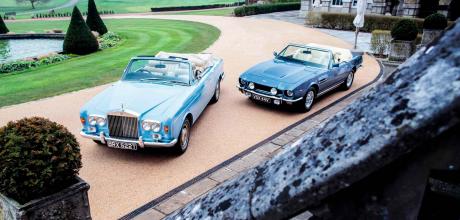1980 Aston Martin V8 Volante vs. 1976 Rolls-Royce Corniche Drophead Coupé
Summer’s on its way, so what better than a luxurious convertible for the season? Robert Coucher considers these two horseless carriages, both with the Royal seal of approval. Photography Drew Gibson.
BY ROYAL APPOINTMENT
LUXURY BRIT DROP-TOPS
Aston Volante and Rolls-Royce Corniche vie for top honours
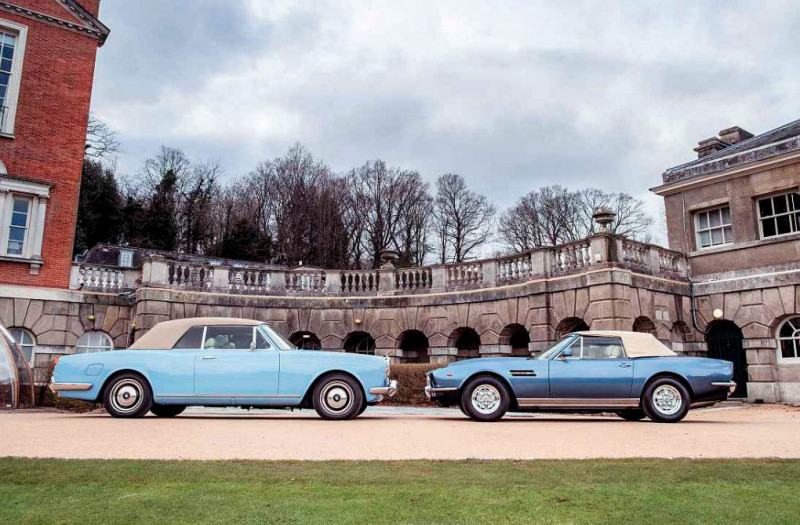
Winter’s chill is receding, daylight creeps ever longer into the evenings. With Spring in the air, it’s time to imagine the delights of setting off on a drive in a decent classic car – hood down, naturally. As for an appropriate destination, what better than the country residence of the Royal Automobile Club? With such a grand port of call in mind, suitable conveyances are required. Roll forward, with leather-lined grace, this pairing of a 1976 Rolls-Royce Corniche Drophead Coupé and 1980 Aston Martin V8 Volante, both marques being holders of the Royal Warrant.
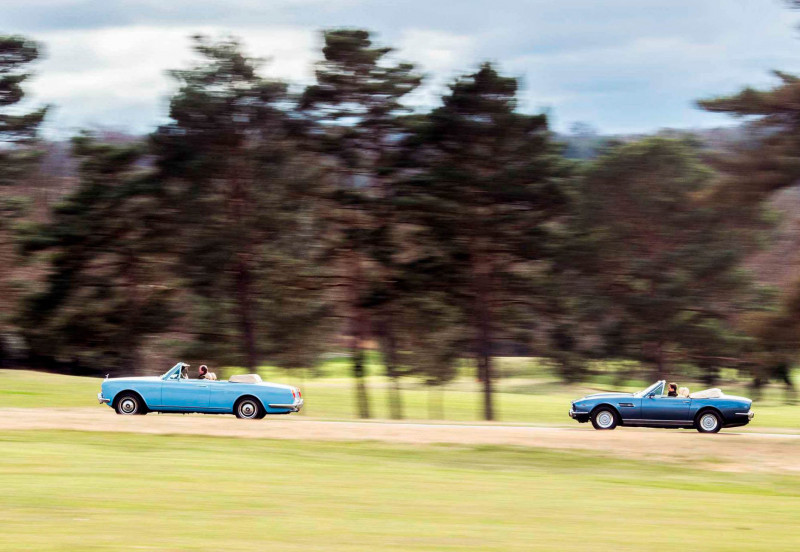

Right Big V8, soft-top, leather-and-walnut interior, British handbuilt pedigree: these two have much in common yet differ greatly in character.
Fortunately the repeal of the Red Flag Act, 126 years ago, under which your man had to proceed ahead of your ‘horseless carriage’ waving a red flag, allowed the Great British motorist the freedom of the public highways. And one organisation that’s been influential in protecting the interests of British motorists ever since is the Royal Automobile Club, based in Pall Mall, the heart of London’s clubland.
A few brave pioneers of the 1890s attempted to encourage the growth of ‘automobilism’ at a time when horseless carriages were regarded with suspicion and scepticism. Harry J Lawson organised the first Emancipation Run in 1896 (the precursor to the London to Brighton Veteran Car Run) to celebrate motoring freedom, and it was followed by the 1000 Mile Trial in 1900. That was staged by the Automobile Club of Great Britain and Ireland, which had been established in 1897 and was the forerunner of the RAC.
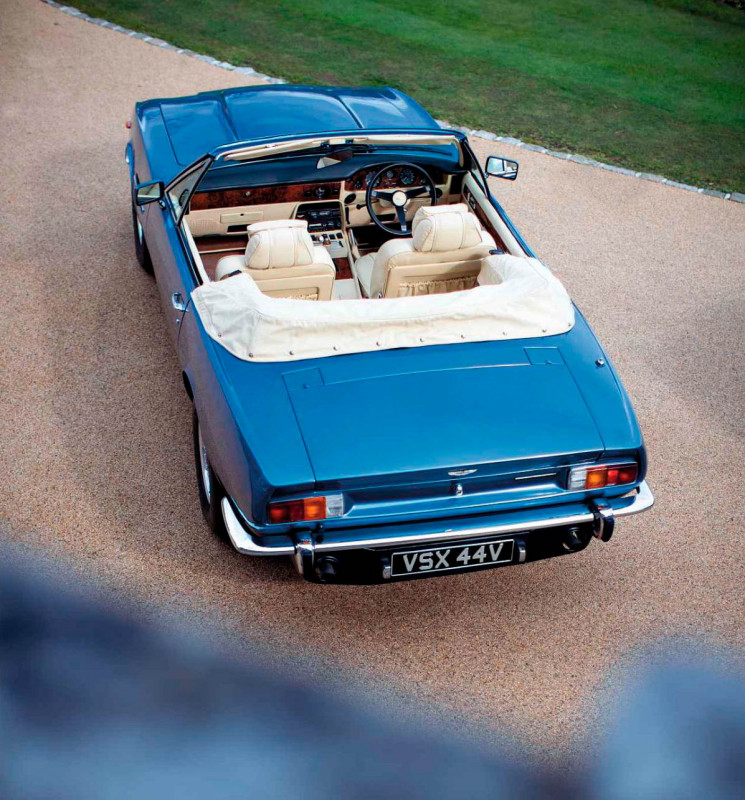
All this helped nudge and lobby the authorities to pass The Motor Car Act into law in 1903, which increased speed limits and removed other restrictions. And in 1905 the Club organised the first Tourist Trophy race, today the oldest motor race to run regularly.
Then, in 1907, it became the ‘Royal’ Automobile Club after King Edward VII (at the time the Prince of Wales) was taken for a blast around Kensington by club founder Simms in a Daimler. HRH was so enthusiastic he allowed his profile to be used on the RAC badge. The first petrolhead, you might quip.
The RAC went on to organise the first British Grands Prix at Brooklands in 1926 and at Silverstone in 1948. Yes, it’s a lot more than just roadside assistance, which it actually demerged in 1999. The club has been instrumental in allowing us to enjoy motoring for over a century.
The two convertibles you see here are all about motoring enjoyment: rare, expensive and refined. There can be few more sumptuous motor cars representing the best of British luxury. And their open-air charm suits Woodcote Park, the 350-acre estate adjacent to Epsom Racecourse, purchased by the Royal Automobile Club in 1913 as a country club for members. It offered them the opportunity to drive their cars out to the countryside, where they could enjoy sport and outdoor pursuits.
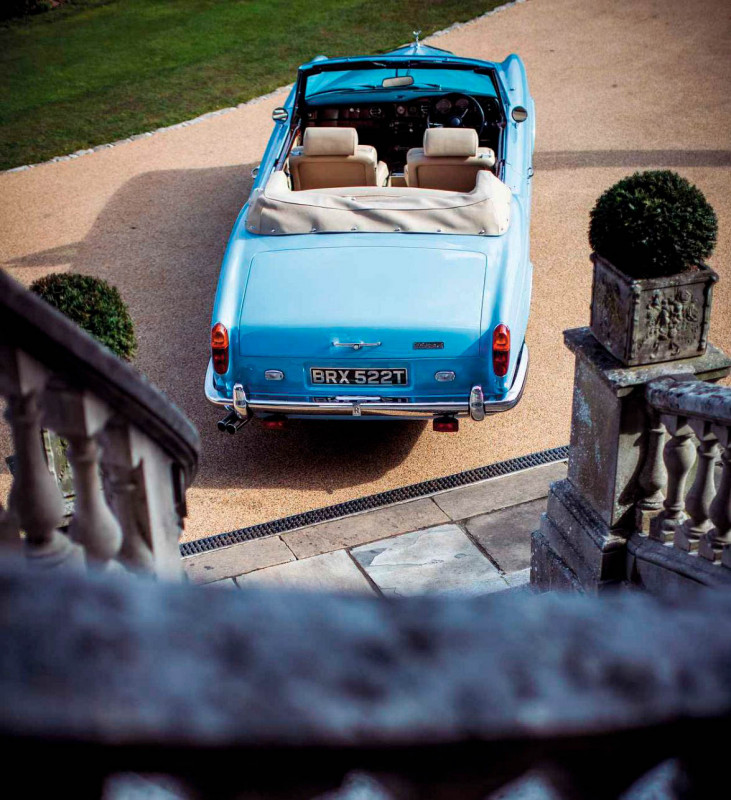
‘Corniche’ and ‘Volante’ conjure images beyond the merely urban, one suggesting a rugged coastline, the other a flight of fancy. With that in mind we fire the mup and head out of London. ‘Fire up’ certainly describes the aural onslaught when starting the Aston’s mighty 5.3-litre V8 – double-overhead-camper bank, with its quartet of Weber carburettors and twin drainpipe-sized exhausts – but the Rolls-Royce has an entirely different demeanour. Finished in striking Iris Blue, the ’Royce is hardly a shrinking violet. It was one of the most expensive cars in the world at the time – half as much again as an already pricey Silver Shadow – and its cost and rarity guaranteed ownership only among the very rich and the very famous.
Built to special order, each was handmade by Mulliner Park Ward in London. And this example is extra-special because it’s a rare mid-series car, referred to as a Series IA, which has most of the Series II modifications but retains the more attractive earlier coachwork and slim chrome bumpers. Upgrades include bi-level air-conditioning, a redesigned fascia, seats, suspension and twin exhausts.
So, those exhausts. Turn the diminutive key in the very traditional Rolls-Royce nacelle located to the right-hand side of the steering wheel and the big Corniche whooshes into action. There is a lot of fan noise and the enormous ‘six-and-three-quarter’ V8 can be heard as you rouse it before it settles to a steady idle, where upon it becomes decorously smooth and quiet. Not as quiet as a standard Shadow because, of course, the Corniche is a ‘sporty’ model. Really? Rolls-Royce tweaked the engine with a higher compression ratio, bigger SU carburettors and that sports exhaust. Power outputs were only ever quoted as ‘adequate’ when new but the Corniche produces about 220bhp and 330lb ft of torque.
To proceed, you select Drive via the dainty steering column-mounted wand, keeping your foot firmly on the brake pedal because the big engine’s torque is ready and on parade. Then off you glide. The overstuffed armchairs perch the driver up high so the view is commanding. The tops of the front wings are visible and the Corniche is actually quite narrow by today’s standards, so it can be punted along with accuracy. The twin-spoke steering wheel is also surprisingly sporty, being a nice size and well-located.
The GM400 auto ’box (the best available in the 1970s) slurs up into third, which is top gear, and the now-warm ’Royce, like a land yacht, picks up onto the plane. Of course, there’s nothing so vulgar as a rev-counter set into the magnificent burr veneered dashboard (that’s below-stairs stuff) and those lovely, heavily chromed air-con vents pump out gallons of cooling air to the face, while your feet are kept as toasty as you like. With powerful vented disc brakes all round, the big ’Royce stops with total authority, which again imparts more confidence than you’d imagine.
The Corniche weighs in at a not inconsiderable 2200kg but, as a Series IA, it is shod with 235/70 x15 radial tyres (the Aston makes do with 225-section tyres), the big V8 has a massive amount of push from idle, the hydraulic self-levelling suspension does its best to keep things on an even keel, and with these superb brakes it all adds up to the ’Royce being on-side when you want to get down to the Grande Corniche on the French Riviera.
Yet this luxurious convertible will never be confused with a sports car because it is such a luxurious carriage for passengers who want to enjoy the extravagances of life. At this it excels. The suspension flattens any impediments and the V8 provides the strength to hit 60mph from rest in around nine seconds and on to a top speed of about 115mph, which is a ridiculous notion – imagine the bills from all the most expensive hairdressing salons that evening! But why hurry? This is a full four-seater with The most opulent Connolly leather interior and thick Wilton carpeting underfoot. The seats are soft and incredibly comfortable and, with that hood stowed under the rear tonneau, the idea is to waft along in mechanical silence with just two fingertips on the steering wheel rim, all the while trying hard not to look too smug.
With its power hood erected the Corniche is almost as refined as a coupé, thanks to the heavily interlined soft-top, and only a little wind noise seems to intrude on motorways at around 80mph. The recirculating-ball steering is a bit vague at indecent speed but, with the hood up or down, the coachwork feels impressively rigid, with little scuttle-shake and no creaks or rattles. Quiet refinement is the order of the day.
These cars are complex – no less than three hydraulic systems – and cost considerable sums to rebuild or restore, so it’s sensible only to consider examples in really perfect condition. This Corniche (as with the smart Aston Martin Volante, brought along today by classic dealership Graeme Hunt Ltd) has spent most of its pampered existence in Jersey, having been purchased new from St Helier Garage. It was originally finished in Nutmeg brown, and the first owner kept it until 2011. There after it was owned by car collector and celebrity DJ Chris Evans. The odometer reads only 18,300 miles, which is why it feels so tight.
In comparison to the regal Rolls-Royce, the lower, more muscular Aston Martin has the more obvious sporting look. With its square-shouldered lines, this Oscar India model features a large cod-piece worked into the aluminium bonnet to clear the gobbling Weber carbs, wood trim in the cabin, a spoiler integrated into the tail, aggressive spotlamps and auxiliary driving lights, and it’s shod with gorgeous period-correct GKN alloy wheels. It looks fast and fearsome, and it is, with a top speed of more than 140mph and a 0-60mph time of 7.0sec. The very British colour combination of Tourmaline Blue paintwork and Magnolia hide suits the car beautifully, and this immaculate example – one of only 157 in right-hand drive – has covered only 66,500 miles from new.
Aston replaced the ageing DB6 with the DBS in 1967. The promised V8 engine was not quite ready by then so the Vantage straight-six was used until 1969, when Tadek Marek’s V8 was first introduced. With its massive (for the time) displacement of 5340cc and various carburettor and fuel-injection fuelling systems, the Aston Martin V8 Vantage was one of the fastest British cars of the period. The convertible Volante you see here is set up for more relaxing grand touring so its engine is tuned to around 300bhp, and it’s coupled to a Chrysler Torqueflite three-speed automatic transmission. Being a soft-top with a powered Everflex hood, it weighs about 70kg more than the regular saloon; its coachwork is all aluminium and entirely hand-built, which required 1200 hours to complete.
Unlike the ’Royce, you climb down into the low-slung Aston Volante. There’s quite a sill to clamber over and the two front seats – like the Corniche’s, they’re trimmed in Connolly’s finest – are fully stuffed, though they hug the body rather more firmly. The interior is attractive though not as high in quality, with Smiths instruments and plastic switches obviously bought-in. The top of the dash is quite high but the steering wheel is neat and the gear selector is located in the traditional spot.
With the Corniche, it’s all about everything except the engine. The Volante is the exact opposite. Its engine is the heart of the beast. Once fired, it is loud and proud and the whole car throbs with soulful verve. If the ’Royce is discreet haute cuisine, the Aston is raw meat.
The big engine is eager to rev – indeed, peak power comes in at 5000rpm – so depress the throttle pedal to the stop: it’s a bit of a bruiser, and encourages a more assertive approach. The quad-cam V8 wakes up and bellows, the Aston squats on its rear de Dion axle and takes off.
The steering is accurate but, whoa, the brakes need a very firm-shove to bring this fast-moving 1800kg brute back down again.
Obviously the Volante is analogue but it’s also wonderfully mechanical. You are more in touch with its dynamics and can feel the engine powering the chassis and the suspension working as it moves. Describing it as a sports car would be a step too far but it’s certainly a grand tourer. While the front seats are very comfortable, the rears are tight but functional as plus twos. So the ’Royce is best at wafting, and the Volante wants to be driven firmly.
These are both luxury convertibles but driving them back-to-back demonstrates that they are actually very different. The Aston Martin V8 Volante is the drivers’ car here, but the Rolls-Royce is the special motor car. Its quality and deportment are on a different level. You’d expect it to be a wonderfully impractical toy but it’s not. Yes, the ’Royce is utterly grand and beautifully crafted, right down to the last heavily chromed switch. Complex but robust and as tight as a drum, while this extravagant piece of automotive indulgence is entirely suited to easing you and your friends down to the splendid Woodcote Park in Surrey, it is just as effective a daily commuter. That’s genius.
THANKS TO the Royal Automobile ClubWoodcote Park Country Club, royalautomobileclub.co.uk, and Graeme Hunt Ltd, graemehunt.com.
‘THESE ARE BOTH LUXURY CONVERTIBLES BUT DRIVING BACK-TOBACK PROVES HOW DIFFERENT THEY ARE’
TECHNICAL DATA 1980 Aston Martin V8 Volante
- Engine 5340cc V8, DOHC per bank, four dual-throat Weber carburettors
- Max Power 310bhp @ 5000rpm
- Max Torque 320lb ft @5000rpm
- Transmission Chrysler Torqueflite three-speed automatic, rear-wheel drive
- Steering Rack and pinion, power assisted
- Suspension Front: double wishbones, coil springs, telescopic dampers, anti-roll bar. Rear: de Dion axle, trailing arms, Watt’s linkage, coil springs, telescopic dampers
- Brakes Vented discs
- Weight 1800kg
- Top speed 140mph
- 0-60mph 7.0sec

Clockwise, from right Tadek Marek-designed quad-cam V8; elegant yet close-coupled interior; detailing is less bespoke than the Rolls-Royce's; characteristic GKN alloy wheels.
‘IN COMPARISON TO THE REGAL ROLLS-ROYCE, THE ASTON MARTIN HAS THE MORE SPORTING LOOK’
TECHNICAL DATA 1976 Rolls-Royce Corniche Drophead Coupé
- Engine 6750cc OHV V8, twin SU carburettors
- Max Power 220bhp@ 4200rpm
- Max Torque 330lb ft @ 1450rpm
- Transmission GM400 three-speed automatic, rear-wheel drive
- Steering Recirculating ball, power-assisted
- Suspension Front: double wishbones, coil springs, telescopic dampers, anti-roll bar, self- levelling.
- Rear: semi-trailing arms, coil springs, telescopic dampers, self-levelling
- Brakes Vented discs
- Weight 2200kg
- Top speed 115mph
- 0-60mph 9.0sec

Clockwise, from far left Full-size luxury car, but big seats make it cosy for four; that ‘63/4’ V8; elegant bumpers pre-date later plastic ones; not a rev-counter by the clock but an external temp gauge.


